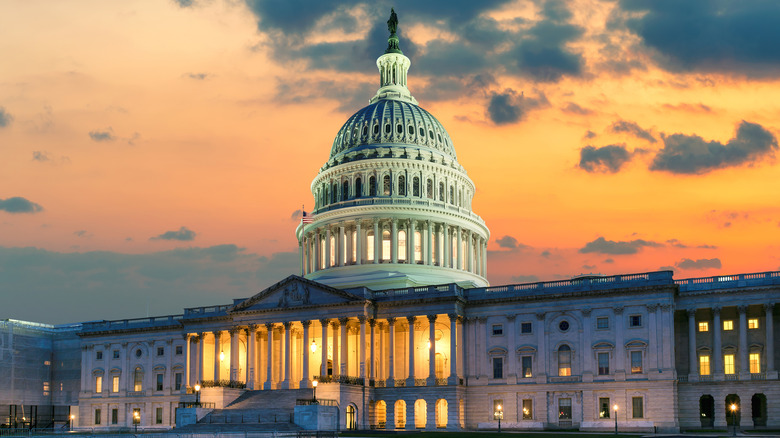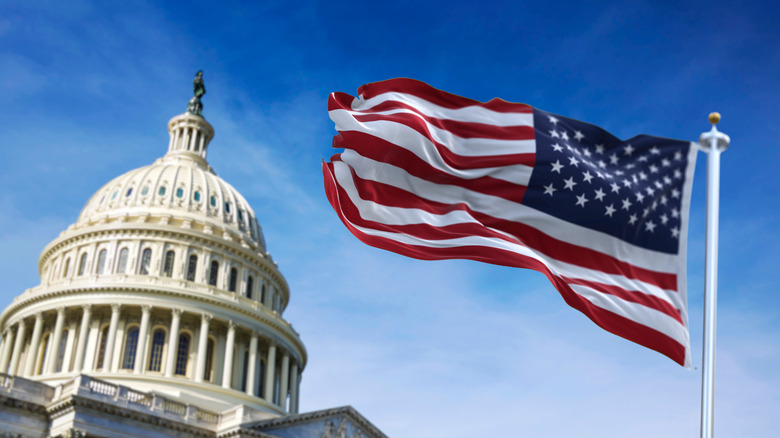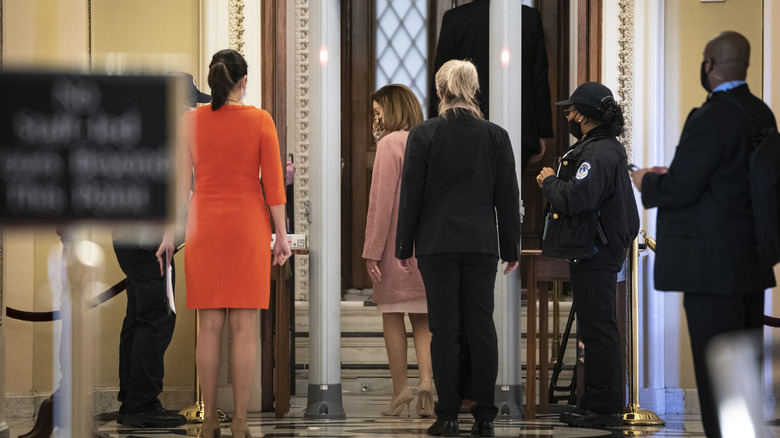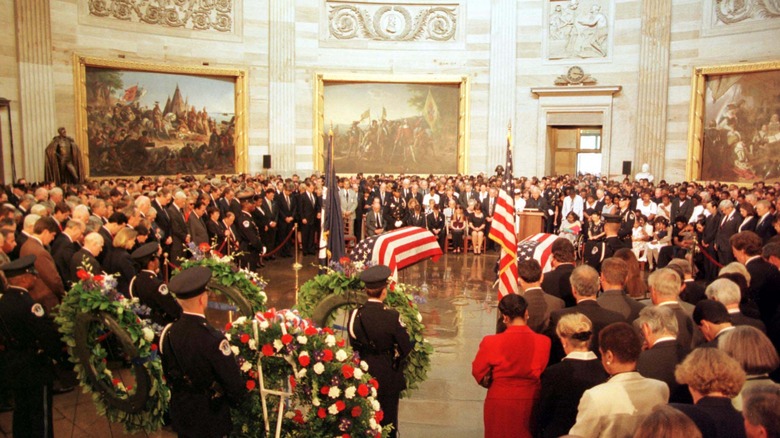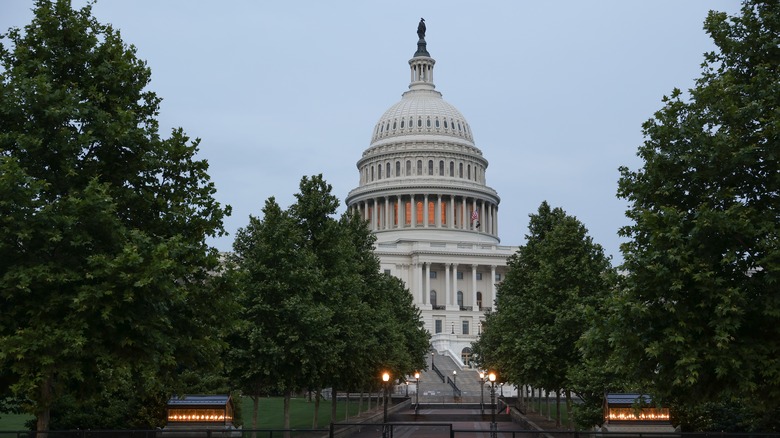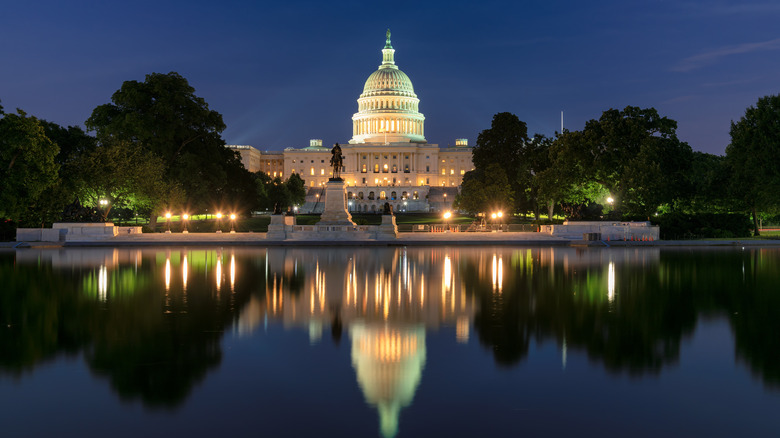The True Story Of The 1998 US Capitol Shooting
On January 6, 2021, the world was made acutely aware of the gaps in security at the U.S. Capitol when some 2,000 rioters breached security and entered the building, clashing with police and causing at least one death (via ABC News). A year and a half later, the dust is still settling from that event, with televised hearings laying out in horrific detail what went on that day and the rioters themselves slowly facing justice. As of July 2022, at least 876 people have been criminally charged in the case, according to Insider.
In fact, in the past two and a half decades, there have been two other major events that pointed out cracks in the security apparatus at not just the Capitol but also other U.S. government institutions. The most dramatic was, of course, the September 11, 2001 terrorist attacks. Though the attacks didn't affect the Capitol, the terrorists did plan on flying a plane into it but were thwarted by the passengers, per Friends of Flight 93. And a few years before those terrorist attacks, a security lapse at the Capitol took place when a man made his way past security checkpoints and shot and killed two people.
The Attack
Like other buildings through which hundreds or thousands of people come and go on a daily basis, the U.S. Capitol building has, and had, different doors for different people who were there for different reasons. On Friday, July 24, 1998, a gunman walked through the metal detectors at one of the entrances (via The Washington Post). Specifically, he entered through the Document Doors on the east side of the building, an entrance reserved for members of Congress and their staff (via Roll Call).
The gunman then opened fire in a crowded building filled with lawmakers, their staff, and an untold number of tourists. Four people caught gunfire in the ensuing chaos, including the gunman himself, who was shot and wounded by a plainclothes officer assigned to the security detail of Tom DeLay, then the House Majority Whip. In addition to the gunman, one tourist was hit; she survived the shooting. Two Capitol Police officers, however, did not survive their injuries.
The Shooter: Russell Eugene Weston Jr.
As previously mentioned, four people were hit in the ensuing gun battle between the shooter and the Capitol Police officers, including the shooter himself. Specifically, as Roll Call reports, Capitol Police officer Detective John M. Gibson shot the assailant and wounded him; Senator Bill Frist, a heart surgeon, provided lifesaving aid to the wounded gunman until he could be taken to a hospital, according to CNN.
The gunman was later identified as Russell Eugene Weston Jr. According to The New York Times, Weston had been living in Montana prior to the attack, where neighbors viewed him as a disturbed recluse. ”He had something against [then-President Bill Clinton]. He was possessed by it. He went on and on," said an employee of a mental hospital where Weston had spent some time prior to the assault. In fact, he'd been sent to that hospital in 1996 for making anti-government statements that had caught the attention of the Secret Service. The police force deemed him a "minor threat" — which is to say, "probably harmless" but "potentially dangerous."
”When he was on his medication, he was fine, he would wave and talk," said a neighbor. Unmedicated, however, his mental illness went unchecked, and the matter culminated a couple of years later when he managed to drive his truck from Montana to Washington D.C., with no clear motive other than causing mayhem.
The Victims
Russell Weston Jr. was able to shoot three people and kill two of them before he himself took a bullet that, though it didn't claim his life, neutralized him and his shooting spree.
According to History of Yesterday, the first person to be hit was Officer Jacob Chestnut. Weston shot him after Chestnut asked him to go back through the metal detector; the bullet struck him in the back of the head, and he died instantly. As employees and tourists dove for cover, plainclothes Detective John Gibson took aim at the gunman and exchanged fire with him; Gibson was mortally wounded and later died at a hospital. A tourist, Angela Dickerson, was struck by a bullet fragment and suffered minor wounds to her shoulder and her face, according to The Washington Post. "I constantly re-see the whole situation, especially with seeing the pictures in the newspaper. It just reflects in my mind and I keep going over and over it," she later said.
The bodies of Chestnut and Gibson were given the exceptionally rare honor of lying in state in the Capitol Rotunda (pictured above). As the Library of Congress explains, they were the first police officers — and Chestnut was the first Black man — to receive that honor.
The Aftermath
Following the deaths of Jacob Chestnut and John Gibson, then-President Bill Clinton was joined by then-Vice President Al Gore, then-Senator Trent Lott, and then-House Speaker Newt Gingrich at a memorial service for the two men, according to C-SPAN. "How fragile is the safety and security we take for granted," said Gore at the event. "Future generations will owe these men a debt outlasting any monument," he added.
Russell Weston Jr. was taken to a Washington hospital to be treated for his injuries and then taken to a mental facility. Over the decades, Weston would be repeatedly deemed not fit to stand trial due to the severity of his mental illness. As of 2018, he was still alive, according to a report in Forbes. Senator Bill Frist, a physician who provided lifesaving treatment to the injured Weston, wrote in Forbes that Weston's case was a microcosm of the failures of the American healthcare system and legal system when it comes to mental illness. "Simply put, we can and must do more to treat those suffering from mental illness — not only for their health and well-being but for the well-being and safety of our society as a whole," he wrote.
Remaining Weaknesses In Capitol Security
Security at the Capitol building has come a long way since that fateful day in 1998 (although, as is patently obvious following the January 6 assault, the security apparatus there is far from infallible). At the time of Russell Weston Jr.'s shooting rampage, just about anybody could walk through parts of the Capitol, provided they made it past a metal detector. Of course, a metal detector only identifies whether or not they have a weapon and doesn't physically stop them from entering the building.
At least some of the security failings that led to the deaths of Jacob Chestnut and John Gibson have been addressed in the three decades since then. As Roll Call reports, more uniformed officers were sent to more Capitol doors, the size of the Capitol Police force itself has doubled, and in perhaps one of the biggest changes to Capitol security, the Capitol Visitor Center was built. According to Capitol Police Chief Matthew Verderosa, this "pushed the threat out, away from the historic nature of the buildings, away from the access points inside the skin of the buildings."
Nevertheless, even after the 1998 Capitol shooting and the attacks of September 11, 2001 three years later, rioters were able to exploit weaknesses in the building's security apparatus on January 6, 2021, leading to a riot inside the building that directly or indirectly led to the deaths of five Capitol Police officers, according to The New York Times.
